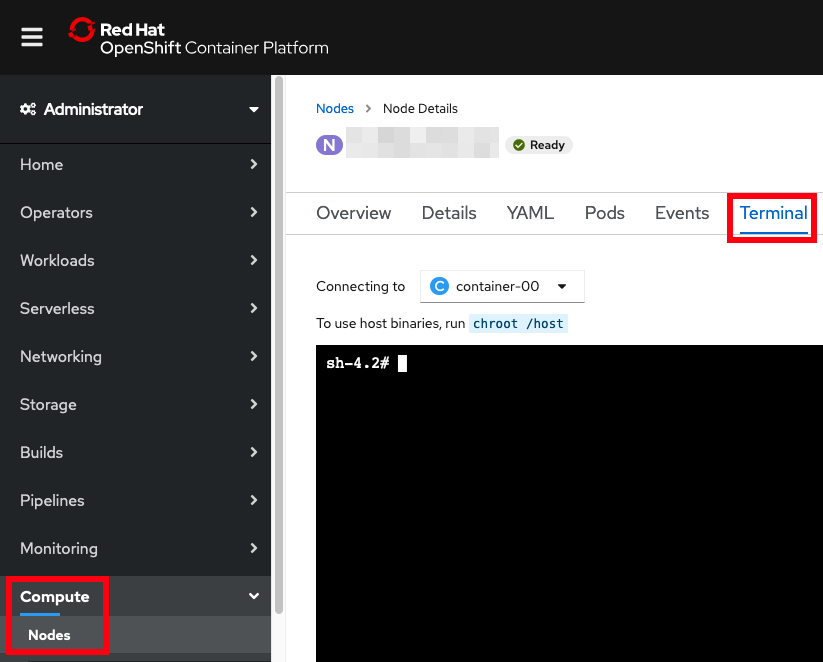- Administrator } Compute } Nodes }
$NODENAME }
Terminal

- Ensure you're logged in with
oc
- Find the relevant node(s):
$ oc get nodes -o wide
NAME STATUS ROLES AGE VERSION INTERNAL-IP EXTERNAL-IP OS-IMAGE KERNEL-VERSION CONTAINER-RUNTIME
...1 Ready master,worker 105d v1.18.3+2fbd7c7 ...1 ...4 Red Hat 3.10.0-1160.2.2.el7.x86_64 cri-o://1.18.3-19.rhaos4.5.git9264b4f.el7
...2 Ready master,worker 105d v1.18.3+2fbd7c7 ...2 ...2 Red Hat 3.10.0-1160.2.2.el7.x86_64 cri-o://1.18.3-19.rhaos4.5.git9264b4f.el7
...4 Ready master,worker 105d v1.18.3+2fbd7c7 ...4 ...0 Red Hat 3.10.0-1160.2.2.el7.x86_64 cri-o://1.18.3-19.rhaos4.5.git9264b4f.el7
- If needed, review node resource usage:
$ oc adm top nodes
NAME CPU(cores) CPU% MEMORY(bytes) MEMORY%
...1 592m 3% 8344Mi 29%
...2 958m 6% 8675Mi 30%
...4 1139m 7% 9523Mi 33%
- Remote into a node:
$ oc debug node/$NODENAME -t
- The debug container is its own container running on the node but
usually you want to act as if you're remote'd into the actual node by
running chroot:
sh-4.2# chroot /host
sh-4.2# whoami
root
- If you need to run utilities that aren't installed on the node, then
you can package
those utilities into an image and then run that image on the node.
Note that the image stream is in a particular project so
-n
must be specified, and note that in this use case, you probably do not
want to run chroot since the relevant binaries are in the
container rather than the node. For example:
$ oc debug node/$NODENAME -t --image=image-registry.openshift-image-registry.svc:5000/$PROJECT/$IMAGE -n $PROJECT
sh-5.0# gcore
usage: gcore [-a] [-o prefix] pid1 [pid2...pidN]
- Either first
chroot /host (in which case you'll lose
access to your debug pod's binaries), or add
--root /host/run/runc after runc.
- Find the PIDs that might be interesting. For example, if we're
searching for a Java PID:
# pgrep -f java
73138
77182
84890
100958
- Use
runc list
to find the container IDs for those PIDs that are in containers. For
example:
# for pid in $(pgrep -f java); do runc list | grep $pid; done | awk '{print $1}'
76d7cbc64b8411fc04390c940fe14c797d4a996a00a56d1014312a7aa7b6d260
1a4a983095d84776603b8d77ff625ace91bb492db12fbee42666145d05324dee
ef77108b440d2ca5631a3781f0bb440e904d86f818457381c0fb820d8f6aa3fd
- Use
runc state
to get details about a container. For example (some output removed):
# runc state 76d7cbc64b8411fc04390c940fe14c797d4a996a00a56d1014312a7aa7b6d260
{
"id": "76d7cbc64b8411fc04390c940fe14c797d4a996a00a56d1014312a7aa7b6d260",
"pid": 73138,
"status": "running",
"bundle": "/var/data/crioruntimestorage/overlay-containers/76d7cbc64b8411fc04390c940fe14c797d4a996a00a56d1014312a7aa7b6d260/userdata",
"rootfs": "/var/data/criorootstorage/overlay/a83cefbb7952694e724af131870657c6b13043f9fc847b7c4757457224a308da/merged",
"created": "2021-02-15T20:36:59.080374202Z",
"annotations": {
"io.container.manager": "cri-o",
"io.kubernetes.container.hash": "6e7830a0",
"io.kubernetes.container.name": "...",
"io.kubernetes.container.ports": "[{\"containerPort\":9443,\"protocol\":\"TCP\"},{\"containerPort\":9080,\"protocol\":\"TCP\"}]",
"io.kubernetes.container.restartCount": "0",
"io.kubernetes.cri-o.Image": "...",
"io.kubernetes.cri-o.Name": "k8s_...-7d57d6599f-5qq7z_..._722d428b-d0ac-4b1e-b4f5-503b1b76c1e4_0",
"io.kubernetes.pod.name": "...-7d57d6599f-5qq7z",
"io.kubernetes.pod.namespace": "...",
},
}
- If needed, go to the rootfs directory for access to the container's
filesystem. For example:
# head /var/data/criorootstorage/overlay/a83cefbb7952694e724af131870657c6b13043f9fc847b7c4757457224a308da/merged/logs/messages.log
********************************************************************************
product = Open Liberty 21.0.0.1 (wlp-1.0.48.cl210120210113-1459)
Previous Section (OpenShift Analyze a Pod Recipe) |
Next Section (OpenShift Investigate ImagePullBackOff Recipe) |
Back to Table of Contents
